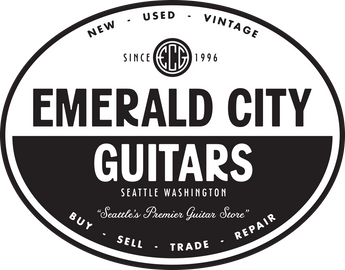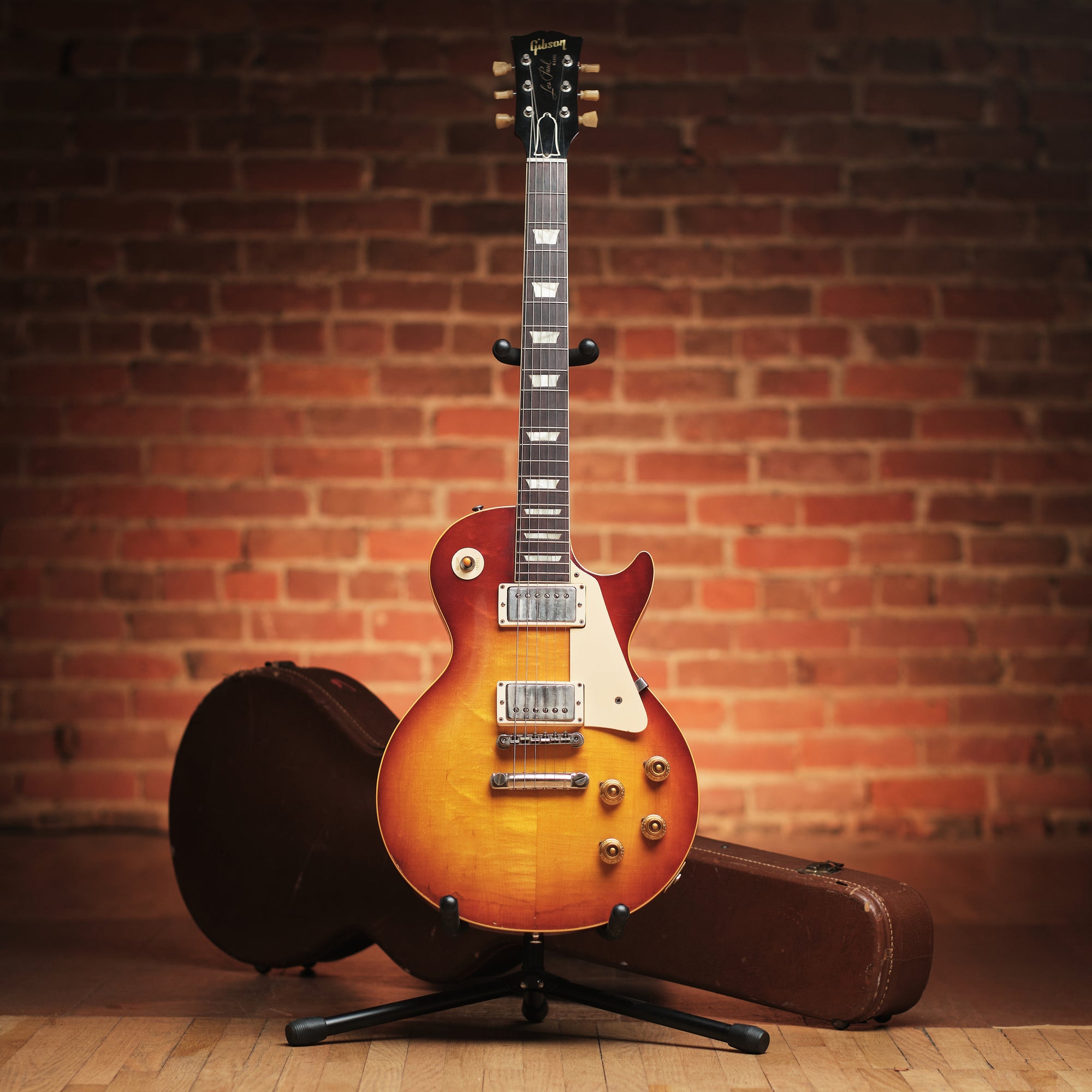1934 Martin D-28
How would you explain to someone the importance of the Gutenberg Bible? The first pair of Levi’s ever made? Ford’s inaugural Model T? The enormity of what is to come just can’t be overstated. This is how we feel about this D-28 #55676, confirmed by Martin to be the very first 14 fret D-28 from the very first batch ever made. Stamped on March 8th, 1934. The first of many.

The provenance of this instrument is bulletproof, but it does warrant some clarification. This is not the first D-28 ever made. From 1931-33 Martin did build a small number of 12 fret Dreadnoughts, but these were special made-to-order guitars and were never carried or offered by dealers. Accordingly, a total of only 17 D-28s were made in the years leading up to 1934. With the popularity of the 14 fret design picking up steam in the early 30s, Martin decided to bring the Dred up to date for the 1934 model year. On February 12th, Martin shipped a 14 fret D-28 prototype to Chicago Musical Instrument Co, one of their main retailers at the time. This guitar was merely a dealer’s sample, and was never offered for sale. CMI must have enjoyed this updated Dreadnought, and ordered the first ever batch of these new D-28s only a week later. It was a small run of 3 instruments, and #55676 was the first of these.
This initial batch did not live happily ever after, though, and for reasons unknown all three of these D-28s had made their way back to Martin for new tops by 1936. Unfortunately, this was the first of many repairs and modifications for this particular guitar. In addition to a handful of repaired back and side cracks, #55676 is currently sporting its 3rd factory Martin top, the most recent being installed in 1956. A new fretboard was crafted in order to facilitate the use of modern T frets, originally this would have been one of the ultra-rare 14 fret Dreds with an ebony rod and bar frets. Some finish work, binding repairs, and a new bridge round out the Carfax for this historic D-28, although I don’t know if any amount of modification could disqualify this thing from being a museum piece.
1938 Martin F-9
Martin made archtops? They sure did, and it very well may be the only reason the company remains in business to this day. We all know that 1930s Martins are considered the best ever made, and accordingly, are among the most expensive guitars ever brought to market.

During the Great Depression, though, the demand for flat tops had followed the economy straight into the gutter. Working musicians made up virtually 100% of the rapidly shrinking guitar-buying sector at this point, and the vast majority of these musicians were playing big band swing on Gibson archtops. Recognizing the importance of this trend, Martin quietly nudged its way into the market in 1931.
The F-9 was not only the company’s premier archtop offering, but was easily the most expensive instrument in their entire catalog at a staggering $250. (This was a time when a D-45 could be had for just $200) It would take nearly 25 years for Martin to manufacture a guitar more costly. Apparently CFM was of the opinion that such a princely sum warranted a completely original design, and took no cues from the industry-standard L-5 and its many impostors. A lightly radiused Brazilian rosewood back, steep neck angle, and glued-on fingerboard extension are unique features that lend a distinct voice to the F-9, blending the best characteristics of a typical archtop and a classic flat top. Only 5 other F-9s were made in 1938, and only 71 were made total during the model’s all-too-brief six year production run. An unfortunate many of these have been gravely damaged or converted into flat tops, so the remaining tally of original examples continues to dwindle every year. As silly as it may seem, no collection of vintage Martins is complete without an F-9, the forgotten king of Nazareth’s golden era.
1965 Fender Jaguar
Fender’s custom colors of the 1960’s are like children to us here at ECG, we love them all equally and couldn’t possibly pick favorites. Like all parents, though, we don’t actually mean this and could easily devise and list a preferential hierarchy on any given day.

By my estimation, Fender custom colors can be broken into 4 tiers. Tier 4: (whom we still love dearly) These are the most common and least-desirable custom colors, Olympic White, Blonde, and Candy Apple Red to some extent. Tier 3: Slightly less common but not unheard of, Fiesta Red, Black, Lake Placid Blue, etc. Tier 2: Seriously rare custom colors, Charcoal Frost Metallic, Blue Ice Metallic, Burgundy Mist, etc. Tier 1: Virtually impossible colors, Shell Pink stands alone on this tier.
Finding an all-original tier 2 Fender is an exciting prospect, and this Jaguar certainly got our attention here at the shop. Apart from the remarkable finish, this example is exactly what you’d want from a 60s Jaguar. The original frets have plenty of life left and are no impediment to terrific playability. The pair of factory Jaguar pickups deliver their quintessential clarity and bite. I’ve always been of the opinion that the Jaguar was a terribly underutilized instrument in honky tonk and country music over the years because of these pickups. Every bit as twangy in the bridge as a blackguard Tele, with a much fuller and more usable neck pickup. A matching Charcoal Frost headstock rounds out this package with the ultimate touch of mid-60s class. It’s not likely another one of these will come around for quite some time.
1925 Martin 0-21
It’s hard to think of a more universally loved musician than the legendary Eric Clapton. His fanbase is as wide and diverse as any in the music industry. A typical Clapton audience can consist of anyone from a retired banker to a retired postal worker, and everyone in between. He’s sold more records than God, and doesn’t seem to be stopping anytime soon. He truly needs no introduction.

While mostly known as an electric guitarist, his prowess as an acoustic player came to public attention after his 1992 appearance on MTV Unplugged. While he may not have used this guitar during that particular performance, it was owned and played by the man himself for many years. This tremendous Martin 0-21 from the waning days of gut strings is truly a finger picker’s dream. After years of faithful service, Mr Clapton put this instrument up for sale at his 2004 Christie’s auction to benefit his Crossroads Antigua addiction treatment center, an event that would eventually result in over $7,000,000 raised. This guitar shared the block with a slough of 50s Gibsons and Fenders, even his iconic ’56 Strat “Blackie.” This Martin comes complete with all Christie’s documentation and provenance, and even the original set of strings from the time of Clapton’s ownership. The opportunity to purchase an instrument that was owned and played by one of the greatest guitar heroes of all time is truly a once-in-a-lifetime chance.
1960 Gibson ES-335
It’s a rare treat to find a vintage 335 that checks all the boxes. The combination of originality and excellent cosmetic condition are rare enough to find in a blue-chip year like 1960. Finding one that has all that, and some killer figuring on the top? There can’t be too many left out there.

This particular example exhibits something we like to call “sneaky flame.” Tops like these may look relatively normal in a dimly lit room or in a Polaroid from 1967, but once properly illuminated they can exhibit breathtaking chatoyancy. (Authors note: “chatoyancy” or “chatoyant” are terms used to describe the three-dimensional quality of wood when observed under bright light. It’s derived from the French term for “shining like a cat’s eye“ and can be used to great effect when attempting to marginalize people who don’t live on guitar forums.)
As much as we love the chunky neck profiles of the two years previous, I do feel that the slimmer ’60 shape doesn’t get a very fair shake. The “bigger is better” philosophy (also present in many Fender disciples) is more often based in fashion rather than empirical preference, in my experience. When judging this or any guitar, an agnostic approach will always result in a happier result for all parties involved. Not willing to give the slimmer neck a chance? Check out the ’59 ES-345 on our site for all the neck you can handle.



